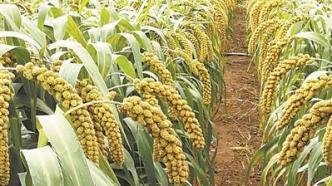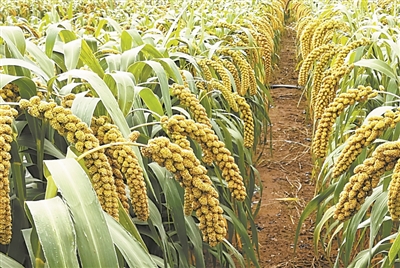

The Institute of Crop Science, Chinese Academy of Agricultural Sciences is an experimental field for large-scale excavation and utilization of millet germplasm resources. Photo courtesy of Institute of Crop Science, Chinese Academy of Agricultural Sciences
On June 10, the reporter learned from the Chinese Academy of Agricultural Sciences that a research paper published by the Institute of Crop Science of the Academy was published in the international journal "Nature Genetics" on the 8th. This achievement deciphered the "heavenly book" of the high-quality map genome of millet, proving that all millet in the world comes from China.
"After 10 years, we conducted an in-depth analysis of 1844 core germplasm resources of millet and its wild species Green Setaria, discovered 1084 loci and genes related to important traits, and drew the first high-quality map genome of millet." The paper communication The author, Diao Xianmin, a researcher at the Institute of Crop Science, Chinese Academy of Agricultural Sciences, told Science and Technology Daily that based on high-coverage and deep sequencing, the study clarified the population structure, classification and evolution relationship of wild millet species, farm varieties and modern bred varieties, and clarified the origin and domestication of millet. The process of improvement; these population genetic evidences clearly show that millet is of single origin, that is, all millet in the world comes from China.
Millet is an ancient crop originating from my country, which belongs to the Gramineae Setaria genus. It is still the main crop of dry farming, and it is also a strategic reserve crop for coping with climate change and arid environments. Its grain is millet, which has high nutritional value and is deeply loved by people.
"my country is the country of origin of millet, and also preserves the most millet resources in the world." Liu Xu, an academician of the Chinese Academy of Engineering, believes that this study clarified the genome variation background of the three types of millet resources: wild species, farm varieties and modern bred varieties. The subgroup classification and geographic distribution of the three types of resources and the possible evolution process were identified, and the theory of the single center of origin of millet, that is, the center of origin in China, was affirmed genetically, which is a typical representative of resource research using new technologies.
In order to decipher the "Book of Heaven" of the graph genome, the research team assembled 110 high-quality genomes of millet and Setaria from scratch on the basis of analyzing the population structure of 1844 core germplasm resources including wild millet species, farm varieties and modern bred varieties, and drew The first genome variation map of Setaria was constructed, and the first high-quality map genome of miscellaneous grains and carbon four (C4) crops was constructed.
"The millet graph pan-genome study published in Nature Genetics is the first high-quality graph pan-genome in the field of miscellaneous grains . This work is not only another 'milestone' work in millet research, but also a contribution to the 'small crop-big crop' As the best interpretation of ', it will play an important role in promoting the research of other crops." Li Jiayang, an academician of the Chinese Academy of Sciences, said.
Crop germplasm resources are the carriers of excellent genes, and the systematic understanding of the genome variation of germplasm resources and the precise identification of phenotypic traits are conducive to the discovery and utilization of excellent genes. The study established an optimal prediction model based on the millet map genome and a genome-wide selective breeding method, which can accelerate crop genetic research and increase the prediction accuracy of millet phenotype by up to 12.6%.
Qian Qian, an academician of the Chinese Academy of Sciences, said that this study allows people to see more clearly the importance of genome structure variation in discovering gene functions, provides a basis for genome and phenotypic data for the millet model plant system, and comprehensively improves the breeding level and quality of millet. The potential of yield and quality has enabled my country to maintain an international leading position in basic research and breeding research of millet.
"These continuous selection genes and trait-associated loci are crucial for the genetic analysis of important traits in millet and marker-assisted breeding. At the same time, as the parallel domestication of multiple crops becomes clearer, the relevant research results also have implications for the inheritance of important traits in other crops." The analysis provides an important reference." Wan Jianmin, an academician of the Chinese Academy of Engineering, said.
It is reported that the research team is mainly responsible for the discovery and innovative utilization of excellent germplasm resources of characteristic crops of the Institute of Crop Science, Chinese Academy of Agricultural Sciences. Diao Xianmin, Michael Purugganan, a professor at the Genomics and Systems Biology Research Center at New York University, and Jia Guanqing, a researcher at the Chinese Academy of Agricultural Sciences, are the co-corresponding authors of the paper.
(Original title "Research proves that millet all over the world comes from China")